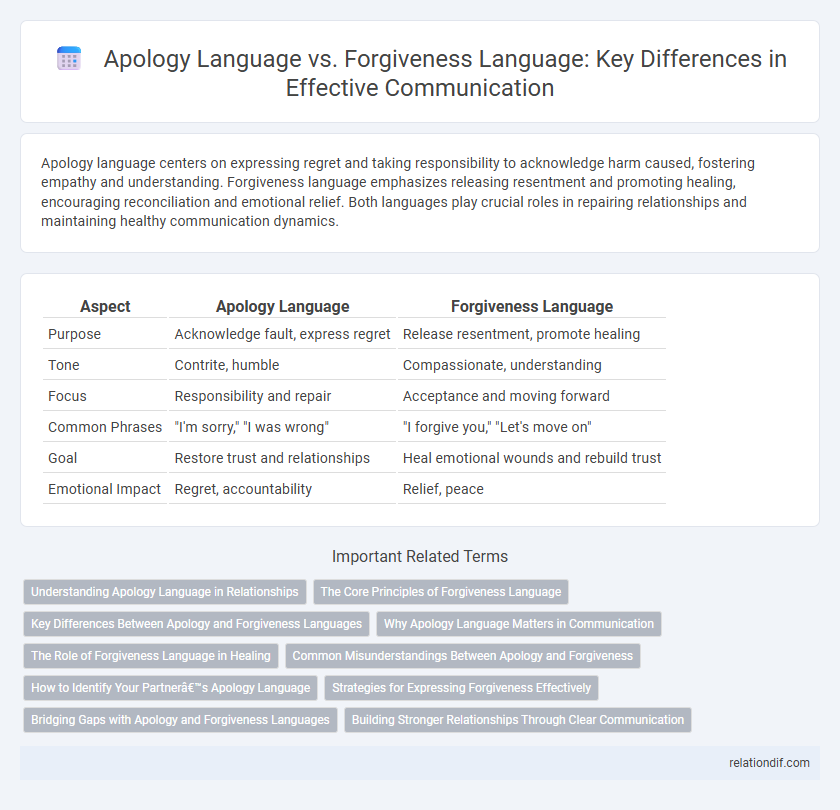Apology language centers on expressing regret and taking responsibility to acknowledge harm caused, fostering empathy and understanding. Forgiveness language emphasizes releasing resentment and promoting healing, encouraging reconciliation and emotional relief. Both languages play crucial roles in repairing relationships and maintaining healthy communication dynamics.
Table of Comparison
| Aspect | Apology Language | Forgiveness Language |
|---|---|---|
| Purpose | Acknowledge fault, express regret | Release resentment, promote healing |
| Tone | Contrite, humble | Compassionate, understanding |
| Focus | Responsibility and repair | Acceptance and moving forward |
| Common Phrases | "I'm sorry," "I was wrong" | "I forgive you," "Let's move on" |
| Goal | Restore trust and relationships | Heal emotional wounds and rebuild trust |
| Emotional Impact | Regret, accountability | Relief, peace |
Understanding Apology Language in Relationships
Understanding apology language in relationships involves recognizing how partners express remorse to repair emotional harm effectively. Apology language varies from taking responsibility and offering explanations to expressing regret and seeking reconciliation, which helps rebuild trust and intimacy. Tailoring apologies to align with a partner's preferred apology style enhances communication and fosters deeper emotional connection.
The Core Principles of Forgiveness Language
Forgiveness language centers on empathy, acceptance, and emotional healing, enabling deeper relational repair compared to apology language, which often emphasizes admitting fault and seeking pardon. Core principles include expressing understanding of the hurt caused, validating feelings without defensiveness, and committing to behavioral change to restore trust. This approach fosters mutual respect, reduces resentment, and promotes genuine reconciliation in interpersonal communication.
Key Differences Between Apology and Forgiveness Languages
Apology language centers on expressing remorse and acknowledging responsibility to repair trust, often including explicit statements like "I'm sorry" or "I was wrong." Forgiveness language emphasizes acceptance and letting go of resentment, frequently using phrases such as "I forgive you" or "Let's move forward," fostering emotional healing and reconciliation. The key differences lie in their communicative intent: apology language aims to validate and amend, while forgiveness language promotes release and restoration of relationships.
Why Apology Language Matters in Communication
Apology language plays a crucial role in communication by acknowledging responsibility and expressing regret, which helps to restore trust and repair emotional damage. Using clear and sincere apology words signals empathy and accountability, fostering positive interpersonal relationships. Effective apology language reduces conflict escalation and promotes mutual understanding, enabling smoother resolution of misunderstandings.
The Role of Forgiveness Language in Healing
Forgiveness language plays a crucial role in emotional healing by fostering empathy and reducing resentment between parties. It shifts the focus from blame to understanding, facilitating reconciliation and restoring trust. Using forgiveness-oriented expressions promotes psychological well-being and strengthens interpersonal relationships by encouraging acceptance and emotional release.
Common Misunderstandings Between Apology and Forgiveness
Apology language often involves expressing regret and acknowledging responsibility, while forgiveness language centers on releasing resentment and moving forward emotionally. A common misunderstanding is conflating an apology with forgiveness; accepting an apology does not guarantee immediate forgiveness, nor does forgiveness require an apology. Clear differentiation between these communicative acts enhances emotional healing and relationship restoration.
How to Identify Your Partner’s Apology Language
Understanding your partner's apology language involves observing their reactions to different forms of apologies, such as verbal expressions, acts of service, or sincere gestures. Pay attention to which apologies resonate most deeply, whether they value heartfelt words, corrective actions, or meaningful time together. Recognizing these preferences enhances communication and strengthens emotional connection through personalized reconciliations.
Strategies for Expressing Forgiveness Effectively
Effective strategies for expressing forgiveness involve using clear and compassionate language that acknowledges the hurt while affirming a desire to move forward. Phrases emphasizing understanding, empathy, and commitment to repairing the relationship, such as "I understand your perspective" or "I am willing to rebuild trust," facilitate emotional healing and mutual respect. Nonverbal communication, including maintaining eye contact and open body language, strengthens the sincerity of forgiveness messages and fosters deeper interpersonal connections.
Bridging Gaps with Apology and Forgiveness Languages
Apology language expresses acknowledgment of wrongdoing and genuine remorse, creating a foundation for healing in strained relationships. Forgiveness language conveys understanding and acceptance, facilitating emotional release and restoring trust between parties. Bridging gaps with these languages fosters mutual respect and promotes effective communication, enabling resolution and deeper connection.
Building Stronger Relationships Through Clear Communication
Apology language involves expressing genuine remorse and acknowledging harm, which fosters trust and accountability in relationships. Forgiveness language emphasizes understanding, empathy, and letting go of resentment, promoting emotional healing and reconciliation. Clear communication using both apology and forgiveness languages strengthens bonds by encouraging openness, reducing conflict, and building mutual respect.
Apology language vs Forgiveness language Infographic

 relationdif.com
relationdif.com